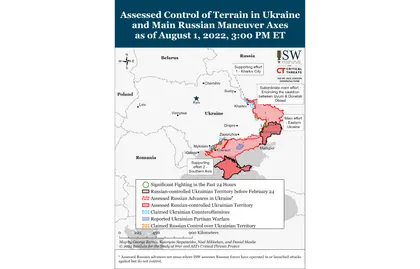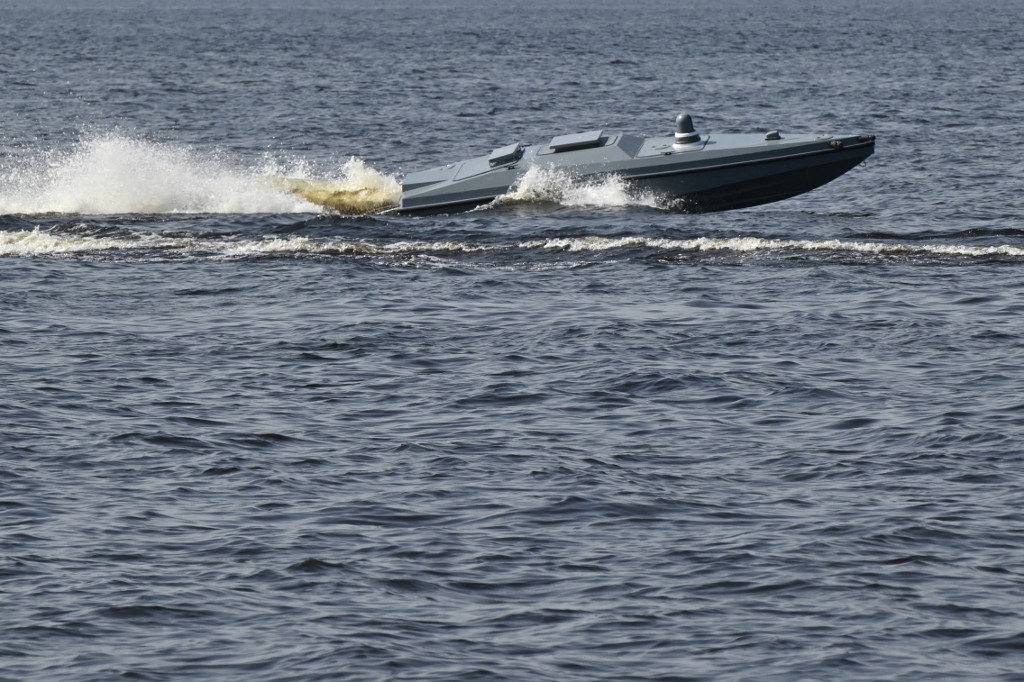Key Takeaways
- ISW assesses that Russian forces were responsible for the July 28 attack on the Olenivka prison that killed 53 Ukrainian POWs; two anonymous US officials confirmed that there is no evidence that Ukrainian forces used US-provided HIMARS, some of the only munitions Ukraine has that are precise enough to do the kind of limited damage seen in satellite and other imagery, to strike the prison.
- Russian forces are transferring elements of the Eastern Military District (EMD) from the Slovyansk area to support defensive positions along the Southern Axis.
- Russian forces did not conduct any offensive operations north of Slovyansk or around Siversk.
- Russian forces conducted unsuccessful ground assaults on settlements south and southeast of Bakhmut.
- Russian proxy authorities did not claim any territorial gains near Avdiivka as Russian forces launched unsuccessful ground assaults on Avdiivka and Pisky.
- Russian regional officials are reportedly failing to provide promised payments to the “Atal” Volunteer Battalion of the Republic of Chuvashia.
- The Kremlin is likely prioritizing propaganda and sham referenda over the welfare of Ukrainian civilians in occupied Ukrainian territories.
- Russian occupation forces are likely increasing efforts to deter and suppress partisan movements in occupied territories as partisan attacks on Russian officials and Ukrainian collaborators continue.
Russian forces are reportedly continuing to transfer troops from northern Donetsk Oblast to support defensive positions in southern Ukraine and may be halting the Slovyansk campaign for the time being. The Ukrainian Main Military Intelligence (GUR) Representative Vadym Skibitsky stated that Russian forces withdrew airborne tactical groups from Donetsk Oblast and redeployed the units to occupied Kherson Oblast territories two weeks ago.[1] Skibitsky added that Russian forces are also redeploying elements of the Eastern Military District (EMD) operating in Slovyansk to southern Ukraine and are transferring a large number of troops to Crimea to prepare to defend occupied Kherson and/or Zaporizhia Oblasts against Ukrainian counteroffensives. The UK Defense Ministry also noted that Russian forces likely identified Zaporizhia Oblast as a vulnerable front in need of reinforcement, and the Ukrainian General Staff reported that Russian forces are regrouping in Zaporizhia Oblast.[2] Social media footage has shown Russian forces moving equipment and personnel to both Zaporizhia and Kherson Oblasts in recent weeks.[3]
JOIN US ON TELEGRAM
Follow our coverage of the war on the @Kyivpost_official.
The Russian withdrawal of some troops from northern Donetsk Oblast will deprive the Slovyansk effort of necessary combat power, in the same way that Russian forces neglected the Zaporizhia and Kherson Oblasts fronts during offensive operations in Luhansk Oblast. The withdrawal will likely create an opportunity for Ukrainian forces to launch a counteroffensive on the Izyum axis, just as the Russian capture of Luhansk Oblast allowed Ukraine to set conditions for a counteroffensive in Kherson Oblast. The Russian redeployment of troops to Zaporizhia Oblast also suggests that Ukrainian counteroffensives are not confined to Kherson Oblast and will likely take place throughout the southern axis.

Russia Is Losing the War in Ukraine: Former Trump Insider Speaks Out
ISW assesses that Russian forces were responsible for the killing of 53 Ukrainian POWs in an explosion at a Russian-controlled prison in Olenivka, Donetsk Oblast on July 28. Two US officials anonymously confirmed to Politico on August 1 that no traces of US-provided High Mobility Artillery Rocket Systems (HIMARS), Ukraine’s most precise artillery system, were found at the prison site.[4] The Kremlin alleges that Ukraine fired HIMARS and precision-guided rockets to kill Ukrainian POWs and deter Ukrainian defectors. Satellite and other imagery from the site indicate that the attack only damaged one building, did not collapse the walls of that building, and did not leave any shell craters in the vicinity, very strongly suggesting that the destruction of the prison was the result of either a precision strike or an internally planted incendiary or explosive.[5] One US official told Politico that “the evidence showed the attack was not conducted by Kyiv.” If Ukraine had used something other than HIMARS to conduct the strike, the attack would almost certainly have left collateral damage around the facility, including craters and other damaged buildings. Given the US assessment that HIMARS were not used in the attack, ISW assesses that Russia was responsible for this attack on Ukrainian POWs in violation of the Geneva Conventions.
Authors: Kateryna Stepanenko, Layne Philipson, Katherine Lawlor, and Frederick W. Kagan
See the full report here.
You can also highlight the text and press Ctrl + Enter






